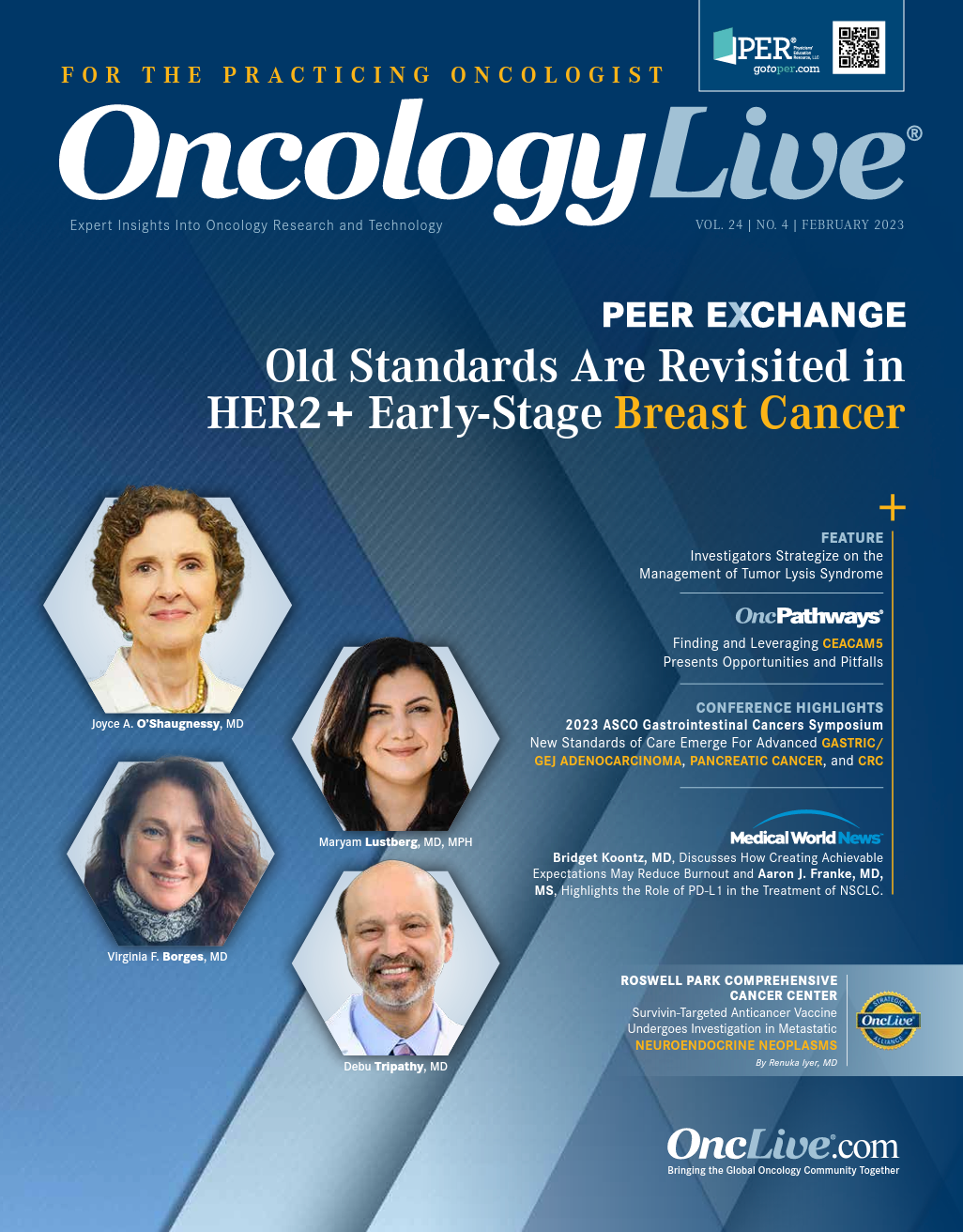Finding and Leveraging CEACAM5 Presents Opportunities and Pitfalls
As carcinoembryonic antigen–related cell adhesion molecule 5 continues to show promise a target in patients with non–small cell lung cancer, refinements in testing and the understanding of the implications of its inhibition remain under investigation.
Chao H. Huang, MD, FACP

As carcinoembryonic antigen–related cell adhesion molecule 5 (CEACAM5) continues to show promise a target in patients with non–small cell lung cancer (NSCLC), refinements in testing and the understanding of the implications of its inhibition remain under investigation.
CEACAM5 has been documented to affect expression of cell cycle and apoptotic genes, which may inhibit the efficacy of agents such as fluorouracil.1 As a cell adhesion molecule, the gene encodes the cell surface glycoprotein, a member of the carcinoembryonic antigen family of proteins.2
Lung cancer, colorectal cancer, and pancreatic cancer have all been documented as having expression of CEACAM5. In NSCLC, CEACAM5 expression and activity in tissue, cell lines, and murine models have been reported using immunohistochemistry (IHC). These analyses confirmed that CEACAM5 stimulated cancer progression in NSCLC through cell proliferation and migration via the p38-SMAD2/3 signaling pathway.3
“It’s more expressed in adenocarcinoma and would potentially be a greater target in non–small cell adenocarcinoma histology,” Chao H. Huang, MD, FACP, said in an interview with OncologyLive®. “It probably does not have as high an expression in squamous cell [disease], therefore, it might be a more viable target in adenocarcinoma as opposed to squamous cell. [This indicates that] we need more options for squamous cell [disease].” Huang is an associate professor and clinical professor of medical oncology at the University of Kansas Medical Center in Kansas City.
Finding and Delivering Effective Therapies
Delivering cytotoxic agents to CEACAM5-expressing tumors has been effective in early studies leveraging antibody-drug conjugates (ADCs). In lung cancer, for example, using the agent tusamitamab ravtansine (SAR408701) is highly selective for CEACAM5, and is designed to deliver a cytotoxic payload of maytansinoid DM4. Additionally, the ADC has a cleavable linker that remains stable in plasma.4
“CEACAM5 [is most often detected] in tissue [and current] clinical trial protocol is to send the tumor biopsy to a central lab to identify expression of this gene through immunohistochemistry [IHC],” Huang said. “[There are different classifications for CEACAM5 expression level based on] the percentage of cancer cells that express it. [Tumors can have] low, intermediate, or high expression.”
Validation of CEACAM5 expression via IHC was conducted in an analysis of samples using the CEACAM5 IHC 769 from Agilent Technologies and Sanofi.5 Using cutoffs of at least 50% expression at least 2+ intensity, the assay was sensitive, specific, precise, reproducible, and robust in evaluating CEACAM5 expression nonsquamous NSCLC.5 The assay was first used for validation in a phase 1/2 study of tusamitamab ravtansine and is now being used in future studies of the agent.5
However, Huang noted that issues that persist with other markers that require testing, exist for CEACAM5 as well, including obtaining adequate and ample tissue samples. “Because [CEACAM5 detection] requires tissue, testing for it can sometimes be a challenge,” he said. “Nowadays, when we do a lung cancer biopsy, we want to do molecular testing, and doing that sometimes exhausts the biopsy sample. It could be a challenge to use additional tissue for this IHC [analysis].”
Other barriers to testing include administrative barriers as well as turnaround time. “Although this antibody [test] can be acquired commercially, this testing is not yet standardized, so we cannot just order it in our laboratory and get it done,” Huang said. “[There is] a specific platform, and [testing is performed] by a central laboratory. In the future, once this platform is validated, [testing] can potentially be done in any laboratory, but our challenge right now is getting the tissue and sending it to the central lab, which can have a turnaround time of 7 to 10 days.”
One avenue forward may come in the form of a blood-based assay. “The more reliable and accurate test is done in tissue. However, in the future, we may develop or refine bloodbased testing to better identify CEACAM5 expression,” Huang said. “Testing in the blood is a bit different [because it] relies on the presence of circulating tumor cells. First you need to identify the cancer cells in the blood, then isolate them and do IHC staining on them. Technically, it can be done, but the challenge is finding those circulating tumor cells. If you don’t find them, you cannot do the testing. Even if you do the testing, [you may not truly find] cancer cells, meaning you could have a false-positive result.”
Alexander I. Spira, MD, PhD, FACP, noted that CEACAM5 is not currently detectable in the blood, but it could be a pathway forward should testing for the marker increase. “It would be great if we had a blood test instead because we wouldn’t [face issues such as] needing to wait for tissue or running out of tissue,” Spira, who is codirector of the Virginia Cancer Specialists Research Institute and the Phase I Trial Program in Fairfax and an assistant professor of oncology at Johns Hopkins School of Medicine in Baltimore, Maryland, said in an interview with OncologyLive®. “This is something that, with hard work, should be surmountable, although it’s proving more challenging [than we initially thought], until CEACAM5 [testing is done routinely]. However, that usually happens once the drug is commercially available, rather than in clinical trials.”
References
- Blumenthal RD, Leon E, Hansen HJ, Goldenberg DM. Expression patterns of CEACAM5 and CEACAM6 in primary and metastatic cancers. BMC Cancer. 2007;7:2. doi:10.1186/1471-2407-7-2
- CEACAM5 CEA cell adhesion molecule 5 [ Homo sapiens (human)] National Cancer Institute. Updated January 1, 2023. Accessed February 2, 2023. https://www.ncbi.nlm.nih.gov/gene/1048#gene-expression
- Zhang X, Han X, Zuo P, Zhang X, Xu H. CEACAM5 stimulates the progression of non-small-cell lung cancer by promoting cell proliferation and migration. J Int Med Res. 2020;48(9):300060520959478. doi:10.1177/0300060520959478
- LaPointe N, Hertle N, Chi Hsu S, et al. Validation of an immunohistochemical assay, CEACAM5 IHC 769, under development for use with the antibody-drug conjugate tusamitamab ravtansine (SAR408701). J Clin Oncol. 2021;39(suppl 15):e21030. doi:10.1200/JCO.2021.39.15_suppl.e21030
- Johnson ML, Chadjaa M, Yoruk S, Besse B. Phase III trial comparing antibody-drug conjugate (ADC) SAR408701 with docetaxel in patients with metastatic non-squamous non-small cell lung cancer (NSQ NSCLC) failing chemotherapy and immunotherapy. J Clin Oncol. 2020;38(suppl 15):TPS9625. doi:10.1200/JCO.2020.38.15_suppl.TPS9625




